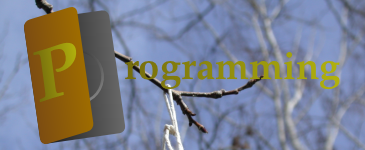
 I kicked off my programming with a football simulator. Titled "tXtFL"™, a name my friend Andrew Chau coined in early 2001 from my original "Text Football League" and the now defunt "XFL," the simulator brought rough-and-tumble football back to the realm of text. I kicked off my programming with a football simulator. Titled "tXtFL"™, a name my friend Andrew Chau coined in early 2001 from my original "Text Football League" and the now defunt "XFL," the simulator brought rough-and-tumble football back to the realm of text.
I had just finished an introductory computer science course at my college and finally fulfilled my dream of writing a computer game. Coded in Scheme, an educational programming language, the game compiled on the fly, required an interpreter, and spit out nothing but text—which means that it fulfilled all my goals, but probably dissatisfied those of everyone else. Still, I hacked away at it for the next semester, continually feeling a tension between my molecular and cell biology coursework and this private programming hobby. I preferred to call it "recreational programming" and found or made many breaks to feed my habit.
A text theme emerges
When classes broke for summer, I broke off tXtFL development. I seemed to have reached the potential of my original design and continually wondered if I should rewrite the project. In the meantime, I looked for another project, something that I would consider more practical for everyday use.
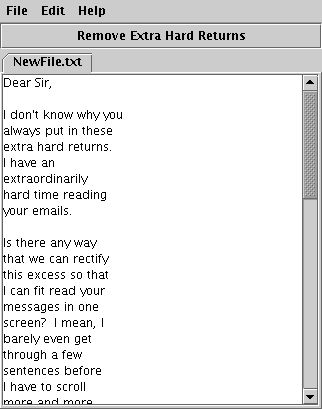 One recurring annoyance I faced during group projects at school was managing email text. A group member would send me an email of text to include in a report, but the text would be smashed into one narrow, un-expanding column. I had to manually delete each hard return at the end of each line. Tedious. Boring. Mechanical. Perfect for programming. What if I created a simple algorithm to strip out these hard returns and restore smooth, word-wrapping text? To make the operation user-friendly, I could also create a text editor to graphically cut and paste the text into. And if I had such an editor, I could use it as a platform to house all sorts of other simple text manipulation algorithms, a sort of tool chest for text tools. Best of all, these tools could be practical or "goofy"—an assortment of practical "tools" or what I called goofy "trix." Productive programming could still be fun. One recurring annoyance I faced during group projects at school was managing email text. A group member would send me an email of text to include in a report, but the text would be smashed into one narrow, un-expanding column. I had to manually delete each hard return at the end of each line. Tedious. Boring. Mechanical. Perfect for programming. What if I created a simple algorithm to strip out these hard returns and restore smooth, word-wrapping text? To make the operation user-friendly, I could also create a text editor to graphically cut and paste the text into. And if I had such an editor, I could use it as a platform to house all sorts of other simple text manipulation algorithms, a sort of tool chest for text tools. Best of all, these tools could be practical or "goofy"—an assortment of practical "tools" or what I called goofy "trix." Productive programming could still be fun.
I devoted a semester or so of programming solely to what emerged as the Text Trix™ writer, the text tinker. After writing a slightly more sophistated version of the "ExtraReturnsRemover" algorithm that originally gave birth to the project, I focused on learning from all my past experience with text edits to create one customizable for all my needs—and hopefully flexible to meet most others' needs, too. Today that program offers a word wrap auto-indenter to graphically align tabbed text for coders, a WYSIWYP (What You See Is What You Print) mechanism to print word-wrapped text aligned exactly as it appears on screen, and a plug-in architecture for developers to write text manipulating tools for users to download and install whichever suits their fancy.
Mike Pao (aka Euzane aaka Paco) expressed to me one night that he would rather play a game like tXtFL than use a text editor. I personally preferred editing to gaming, but I saw his point, and a flame of tXtFL reignited inside me. 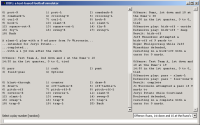 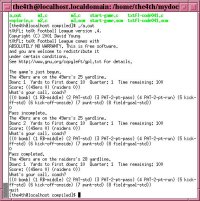 Experienced now with the more powerful, flexible Java programming language, which I had learned through my Beneath Enemy Lines submarine simulator flop and honed in the Text Trix writer, I now employed the language for a modern update to and extension of the original tXtFL idea. Bearing the same name, tXtFL has emerged as a graphical, text-focused football simulator that concentrates on coaching and team management. Experienced now with the more powerful, flexible Java programming language, which I had learned through my Beneath Enemy Lines submarine simulator flop and honed in the Text Trix writer, I now employed the language for a modern update to and extension of the original tXtFL idea. Bearing the same name, tXtFL has emerged as a graphical, text-focused football simulator that concentrates on coaching and team management.
A theme began to emerge from my projects. For some reason I consistently focused on text. In many walks of life I found that understanding something usually boiled down to knowing the plain text, which captured the frank and accurate expression of what actually happened or how someone felt deep inside. By reducing a football game to a sequence of text, I felt that tXtFL could help coaches to focus on the strategy behind team and play management. With Text Trix, people could focus on the text itself, from email text to HTML web code, while still viewing it with ease.
Text Flex™ is born
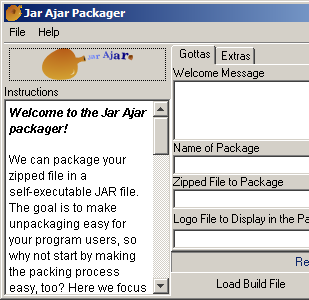 With two text-focused software programs and a third one, the Jar Ajar™ packaging suite designed to deploy the Text Trix writer across multiple platforms and for a technically varied audience, on the way, I decided that these programs might need the backing of a business infrastructure. I created my own, Text Flex™, a company concentrating on text-focused software. The common thread among this software is a focus on utilizing the simple flexibility of text through friendly, graphical interfaces. The motto: "We've got text appeal."™. With two text-focused software programs and a third one, the Jar Ajar™ packaging suite designed to deploy the Text Trix writer across multiple platforms and for a technically varied audience, on the way, I decided that these programs might need the backing of a business infrastructure. I created my own, Text Flex™, a company concentrating on text-focused software. The common thread among this software is a focus on utilizing the simple flexibility of text through friendly, graphical interfaces. The motto: "We've got text appeal."™.
 One joy of working for Text Flex is that I can code software and manage business operations almost entirely with open-source tools, such as Text Trix and its word-wrap auto-indenter. The delight in computers that eventually led to my forray in programming back in 2001 began with the open source GNU/Linux® operating system. While I greatly appreciate and use proprietary software on a daily basis, I feel particularly indebted to the vast number of programmers who have devoted their night hours to writing production-strength application ranging from office suites and web browsers to image editors and software compilers. I feel honored to contribute back to this wealth of code with my own. One joy of working for Text Flex is that I can code software and manage business operations almost entirely with open-source tools, such as Text Trix and its word-wrap auto-indenter. The delight in computers that eventually led to my forray in programming back in 2001 began with the open source GNU/Linux® operating system. While I greatly appreciate and use proprietary software on a daily basis, I feel particularly indebted to the vast number of programmers who have devoted their night hours to writing production-strength application ranging from office suites and web browsers to image editors and software compilers. I feel honored to contribute back to this wealth of code with my own.
Copyright © 2003-4 David Young
|

 I kicked off my programming with a football simulator. Titled "tXtFL"™, a name my friend Andrew Chau coined in early 2001 from my original "Text Football League" and the now defunt "XFL," the simulator brought rough-and-tumble football back to the realm of text.
I kicked off my programming with a football simulator. Titled "tXtFL"™, a name my friend Andrew Chau coined in early 2001 from my original "Text Football League" and the now defunt "XFL," the simulator brought rough-and-tumble football back to the realm of text. One recurring annoyance I faced during group projects at school was managing email text. A group member would send me an email of text to include in a report, but the text would be smashed into one narrow, un-expanding column. I had to manually delete each hard return at the end of each line. Tedious. Boring. Mechanical. Perfect for programming. What if I created a simple algorithm to strip out these hard returns and restore smooth, word-wrapping text? To make the operation user-friendly, I could also create a text editor to graphically cut and paste the text into. And if I had such an editor, I could use it as a platform to house all sorts of other simple text manipulation algorithms, a sort of tool chest for text tools. Best of all, these tools could be practical or "goofy"—an assortment of practical "tools" or what I called goofy "trix." Productive programming could still be fun.
One recurring annoyance I faced during group projects at school was managing email text. A group member would send me an email of text to include in a report, but the text would be smashed into one narrow, un-expanding column. I had to manually delete each hard return at the end of each line. Tedious. Boring. Mechanical. Perfect for programming. What if I created a simple algorithm to strip out these hard returns and restore smooth, word-wrapping text? To make the operation user-friendly, I could also create a text editor to graphically cut and paste the text into. And if I had such an editor, I could use it as a platform to house all sorts of other simple text manipulation algorithms, a sort of tool chest for text tools. Best of all, these tools could be practical or "goofy"—an assortment of practical "tools" or what I called goofy "trix." Productive programming could still be fun.

